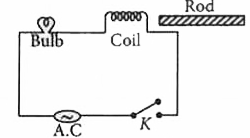Light of two different frequencies whose photons have energies 1 eV and 2.5 eV respectively, successively illuminate a metallic surface whose work function is 0.5 eV. Ratio of maximum speeds of emitted electrons will beSolution in Kannada
1:4
1:1
1:5
1:2
The correct Answer is:D
According to Einstein's photogenic equation , the maximum kinetic energy of emitted photoelectrons is
Kmax=hv−ϕ0
where hv is the energy of incident and ϕ0 is the work function .
But Kmax=12mv2max
∴12mv2max=h∨−ϕ0
As per equation
12mvmax=1eV−0.5eV=0.5eV....(i)
and and12mv2max2=2.5eV−0.5eV=2eV ...(ii)
Dividing eqn . (i) by eqn . (ii) , we get
v2max1v2max2=0.5eV2eV=14
vmax1vmax2=√14=12
Topper's Solved these Questions
Similar Questions
A solenoid length 0.4cm, radius 1 cm and 400 turns of wire. If a current of 5 A is passed through this solenoid, what is the magnetic field inside the solenoid ?
01:38View SolutionIn the A. C. circuit shown, keeping 'K' pressed, if an iron rod is inserted into the coil, the bulb in the circuit
 02:58View Solution
02:58View SolutionLights of two different frequencies whose photons have energies 1 and 2.5 eV, respectively, successively illuminate a metal whose work function is 0.5 eV. The ratio of the maximum speeds of the emitted electrons
02:54View SolutionLight of two different frequencies whose photons have energies 1eV and 2.5 eV respectively illuminate a metallic surface whose work function is 0.5 eV successively. Ratio of maximum kinetic energy of emitted electrons will be:
03:28View SolutionLights of two different frequencies whose photons have energies 1 eV and 2.5 eV respectively illuminate successively a metal surface whose work function is 0.6 eV. The ratio of the maximum speeds of the emitted electrons will have
03:28View SolutionLights of two different frequencies, whose photons have energies 1 eV and 2.5 eV respectively, successively illuminate a metal whose work function is 0.5 eV. The ratio of the maximum speeds of the emitted electrons will be
03:55View SolutionLight of two different frequencies whose photons have energies 1 eV and 2.5 eV respectively, successively illuminate a metallic surface whose work function is 0.5 eV. Ratio of maximum speeds of emitted electrons will be
04:49View SolutionLight of two different frequencies whose photons have energies 1 eV and 2.5 eV respectively illuminate a metallic surface whose work function is 0.5 eV successively. Find the ratio of maximum speeds of emitted electrons.
03:40View SolutionLights of two different frequencies whose photons have energies 1 and 2.5 eV, respectively, successively illuminate a metal whose work function is 0.5 eV. The ratio of the maximum speeds of the emitted electrons
02:19View SolutionLights of two different frequencies whose photons have energies 1 eV and 2.5 eV respectively illuminate successively a metal surface whose work function is 0.7 eV. The ratio of the maximum speeds of the emitted electrons will have
02:57View SolutionLight of two different frequencies whose photons have energies 1eV and 2.5 eV respectively illuminate a metallic surface whose work function is 0.5 eV successively. Ratio of maximum kinetic energy of emitted electrons will be:
02:17View SolutionLights of two different frequencies whose photons have energies 1 and 2.5 eV, respectively, successively illuminate a metal whose work function is 0.5 eV. The ratio of the maximum speeds of the emitted electrons
03:19View SolutionLight of two different frequencies whose photons have energies 1eV and 2.5 eV respectively illuminate a metallic surface whose work function is 0.5 eV successively. Ratio of maximum kinetic energy of emitted electrons will be:
View SolutionLight of two different frequencies whose photons have energies 1eV and 2.5 eV respectively illuminate a metallic surface whose work function is 0.5 eV successively. Ratio of maximum kinetic energy of emitted electrons will be:
View SolutionLight of two different frequencies whose photons have energies 1 eV and 2.5 eV respectively, successively illuminate a metallic surface whose work function is 0.5 eV. Ratio of maximum speeds of emitted electrons will be
01:48View Solution

